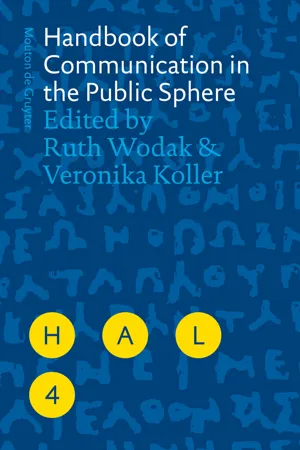
Handbook of Communication in the Public Sphere
- 482 pages
- English
- PDF
- Available on iOS & Android
Handbook of Communication in the Public Sphere
About this book
As you are reading this, you are finding yourself in the ubiquitous public sphere that is the Web. Ubiquitous, and yet not universally accessible. This volume addresses this dilemma of the public sphere, which is by definition open to everyone but in practice often excludes particular groups of people in particular societies at particular points in time. The guiding questions for this collection of articles are therefore: Who has access to the public sphere? How is this access enabled or disabled? Under what conditions is it granted or withheld, and by whom?
We regard the public sphere as the nodal point for the discourses of business, politics and media, and this basic assumption is also s reflected in the structure of the volume. Each of these three macro-topics comprises chapters by international scholars from a variety of disciplines and research traditions who each combine up-to-date overviews of the relevant literature with their own cutting-edge research into aspects of different public spheres such as corporate promotional communication, political rhetoric or genre features of electronic mass media.
The broad scope of the volume is perhaps best reflected in a comprehensive discussion of communication technologies ranging from conventional spoken and written formats such as company brochures, political speeches and TV shows to emerging ones like customer chat forums, political blogs and text messaging.
Due to the books' wide scope, its interdisciplinary approach and its clear structure, we are sure that whether you work in communication and media studies, linguistics, political science, sociology or marketing, you will find this handbook an invaluable guide offering state-of-the -art literature reviews and exciting new research in your field and adjacent areas.
Frequently asked questions
- Essential is ideal for learners and professionals who enjoy exploring a wide range of subjects. Access the Essential Library with 800,000+ trusted titles and best-sellers across business, personal growth, and the humanities. Includes unlimited reading time and Standard Read Aloud voice.
- Complete: Perfect for advanced learners and researchers needing full, unrestricted access. Unlock 1.4M+ books across hundreds of subjects, including academic and specialized titles. The Complete Plan also includes advanced features like Premium Read Aloud and Research Assistant.
Please note we cannot support devices running on iOS 13 and Android 7 or earlier. Learn more about using the app.
Information
Table of contents
- Frontmatter
- Contents
- Introduction: Shifting boundaries and emergent public spheres
- 1. Language, communication and the public sphere: Definitions
- 2. Public space, common goods, and private interests: Emergent definitions in globally mediated humanity
- 3. Media discourse and the naturalisation of categories
- 4. Language, communication and the public sphere: A perspective from feminist critical discourse analysis
- 5. Advertisements and Public Relations
- 6. Language and communication design in the marketplace
- 7. Identity, image, impression: Corporate self-promotion and public reactions
- 8. Creating a “green” image in the public sphere: Corporate environmental reports in a genre perspective
- 9. Britain™ and “corporate” national identity
- 10. Political terminology
- 11. Rhetoric of political speeches
- 12. Dissemination and implementation of political concepts
- 13. The contribution of critical linguistics to the analysis of discriminatory prejudices and stereotypes in the language of politics
- 14. Tabloidisation of political communication in the public sphere
- 15. News genres
- 16. Specific genre features of new mass media
- 17. Specific debate formats of mass media
- 18. The sounds of silence in the media: Censorship and self-censorship
- 19. Technology, democracy and participation in space
- Backmatter